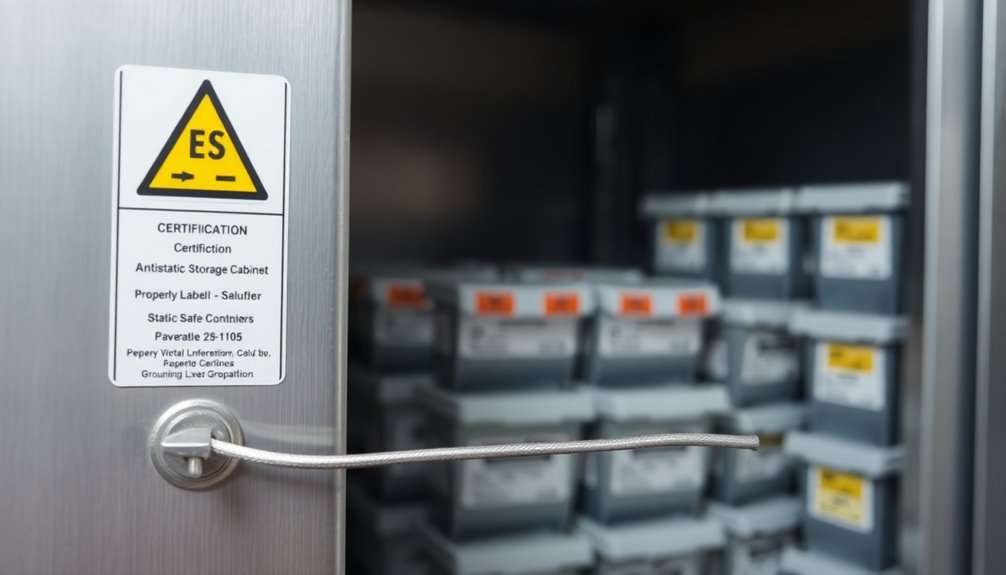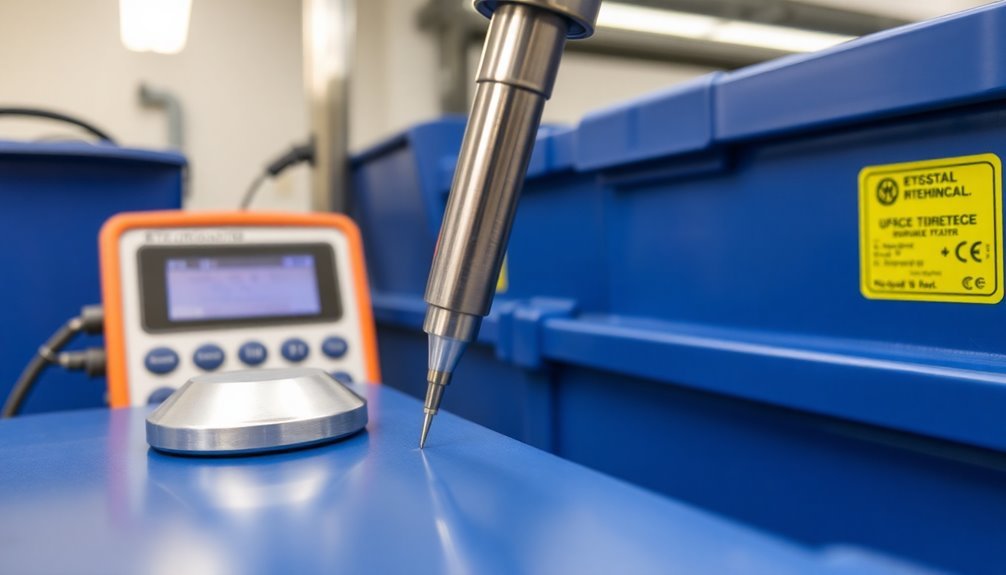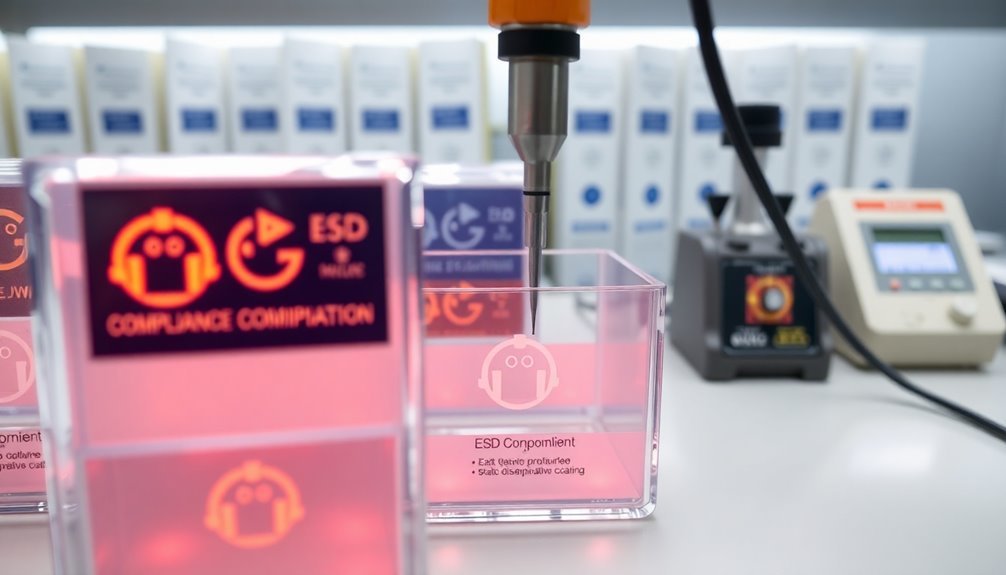Essential certifications for static-safe storage products include ANSI/ESD S20.20, IEC 61340-5-1, and ISO 9001:2015 for overall ESD control program compliance. You'll also need MIL-STD-2073 and MIL-STD-129 certification if you're handling military components. ANSI/ESD S541 certification confirms your packaging materials meet ESD-sensitive item requirements, while IEC 61000-4-2 validates your products' resistance to static discharge. When implementing these certifications, you'll need to maintain regular testing protocols, proper documentation, and employee training programs. Understanding the complete scope of these standards will strengthen your ESD protection strategy.
Understanding ESD Certification Standards

When protecting sensitive electronic components, understanding ESD certification standards is crucial for implementing effective static-safe storage solutions. The two primary standards you'll need to know are ANSI/ESD S20.20 and IEC 61340-5-1, which govern facility certification for static-safe environments.
These standards cover everything from manufacturing and assembly to packaging and transport of ESD-sensitive items. Annual recertification audits are required to maintain compliance with these standards.
You'll find that these certifications follow the ISO 9001:2015 Quality Management Systems framework, guaranteeing a systematic approach to ESD protection. The standards focus on three fundamental control principles: grounding control for conductors, control measures for non-conductors, and proper transportation and storage protocols.
To validate your storage solutions, you'll need to evaluate the testing requirements outlined in IEC 61000-4-2, which specifies contact discharge levels from 2kV to 8kV and air discharge up to 15kV. Your storage products must meet these rigorous testing standards to guarantee they'll protect sensitive components effectively.
Remember that specific industries may require additional certifications, such as EN 60601-1-2 for medical devices or ISO 10605 for automotive applications.
Military Packaging Requirements
Every military-grade static-safe storage solution must comply with stringent Department of Defense (DoD) packaging standards, particularly MIL-STD-2073 and MIL-STD-129. When you're packaging military items, you'll need to guarantee your storage products meet specific anti-static requirements while providing electromagnetic shielding and tamper-evident features.
To achieve military packaging compliance, you'll need to focus on these critical elements:
- Select materials that offer proven protection against environmental factors, static discharge, and rough handling while maintaining structural integrity during transport.
- Implement proper labeling systems that include part numbers, lot numbers, serial numbers, and clear handling instructions following MIL-STD-129 guidelines.
- Conduct thorough testing for shock resistance, vibration tolerance, and environmental durability according to military specifications.
You'll need to maintain detailed documentation of your packaging specifications and test results throughout the compliance process. Clear communication between different military systems is essential for properly identifying, tracking, and storing items. Remember that military packaging requirements extend beyond basic static protection – they're designed to guarantee your products survive various environmental conditions during worldwide shipment and storage.
Your storage solutions must demonstrate consistent performance in structural integrity tests while meeting specific preservation methods outlined in military standards.
Static Control Testing Methods

Testing your static control measures requires adherence to rigorous international standards, particularly IEC 61000-4-2, which defines essential test procedures and requirements.
You'll need to perform both contact and air discharge testing using specified voltage levels: 2-8 kV for contact discharge and up to 15 kV for air discharge. Temperature and humidity must be strictly controlled to ensure consistent and reliable test results.
To conduct proper testing, you'll need an ESD gun, Ground Reference Plane (GRP), and coupling planes (HCP and VCP). You must apply test pulses at one-second intervals, with at least 10 discharges for each polarity. Start from the lowest test voltage and work your way up to maximum discharge levels, verifying you test all four sides of your equipment under test (EUT).
Your compliance verification process should include regular audits following ANSI/ESD S20.20 and IEC 61340-5-1 standards.
You'll need to maintain detailed records and trend charts to monitor your ESD control process effectiveness. It's recommended that you establish a schedule for daily, weekly, or monthly checks of your procedures and materials.
Consider bringing in third-party consultants for thorough ESD audits to verify your static control measures meet all necessary certifications and standards.
EPA Storage Container Guidelines
Under EPA regulations, your storage containers for hazardous materials must meet strict design and operational requirements. Your containers must be made from materials that are compatible with their contents, featuring tight-fitting lids and clear labeling that identifies both contents and hazards. Conductive containers manufactured with carbon black materials provide permanent conductivity for safe storage.
Your facility must also implement secondary containment systems designed to prevent leaks and manage potential spills effectively.
- You must keep containers closed at all times except when adding or removing waste
- You'll need to train your personnel in proper handling techniques and spill response
- You're required to maintain detailed records of all container management activities
When managing empty containers, you'll need to follow specific residue limits. For containers up to 119 gallons, there shouldn't be more than 2.5 cm of material or 3% by weight remaining. Larger containers over 119 gallons must contain no more than 0.3% by weight of residue.
You must label empty containers with both their empty status and the date emptied. Remember that any rinsate from cleaning these containers requires proper hazardous waste management if it contains hazardous constituents.
Your facility's compliance with these guidelines is subject to regular inspections, so maintaining proper documentation is essential.
Material Compliance Verification

A robust material compliance verification process forms the backbone of static-safe storage implementation. You'll need to guarantee your materials meet ANSI/ESD S541 standards while maintaining detailed documentation of all testing and verification procedures. Your compliance program should include regular audits, equipment testing, and thorough material analysis.
To verify material compliance effectively, you'll need to implement both physical and chemical testing protocols. Cross-reference your material test reports with industry standards and consider engaging third-party laboratories for independent verification. Implementing test method standards helps ensure prevention-based process control and continuous quality improvement.
| Verification Type | Required Tests | Frequency |
|---|---|---|
| Physical Analysis | Tensile, Hardness | Quarterly |
| Chemical Testing | Composition, Purity | Semi-annually |
| ESD Properties | Surface Resistance | Monthly |
Your verification process must include regular training of personnel on ESD control practices and maintaining TVC (traceable, verifiable, and complete) records. Don't forget to conduct periodic reviews of your suppliers' material certifications and mill test reports. By following these verification procedures, you'll guarantee your static-safe storage materials consistently meet regulatory requirements while maintaining their protective properties throughout their lifecycle.
Frequently Asked Questions
How Often Should ESD Protective Packaging Be Replaced in Storage Facilities?
You should replace your ESD protective packaging annually or before use, but you'll need to check more frequently based on storage conditions. With proper controlled environments, your ESD bags can last up to 5 years.
Can Esd-Safe Containers Be Reused After Cleaning With Standard Cleaning Products?
No, you shouldn't use standard cleaning products on ESD-safe containers. They'll compromise the container's static dissipative properties. You must use specialized ESD-safe cleaning agents to maintain proper protection for sensitive electronics.
What Temperature Ranges Affect the Performance of Esd-Protective Storage Materials?
You'll find ESD-protective storage materials perform best between 40°F to 225°F. Don't expose them to temperatures outside this range, as you'll risk compromising their static-dissipative properties and protective effectiveness.
Are There Specific Humidity Requirements for Storing Esd-Safe Packaging Materials?
You'll need to maintain relative humidity between 40-60% for ideal ESD protection. Don't let it exceed 60% to avoid corrosion, and don't go below 40% as it reduces the packaging's static-dissipative properties.
How Long Do ESD Certification Labels Remain Valid on Storage Containers?
You'll find ESD certification labels typically remain valid for up to 5 years when properly stored. However, you should test annually and replace labels if they show wear, regardless of age. Don't rely on expired certifications.
In Summary
You'll need to verify that your static-safe storage products meet all seven essential certifications to protect sensitive electronic components. Don't skip military packaging standards or EPA guidelines when selecting containers. Make sure you've properly tested materials and obtained compliance verification. Regular audits of your storage solutions will help maintain ESD protection and keep your components safe from static damage.





Leave a Reply